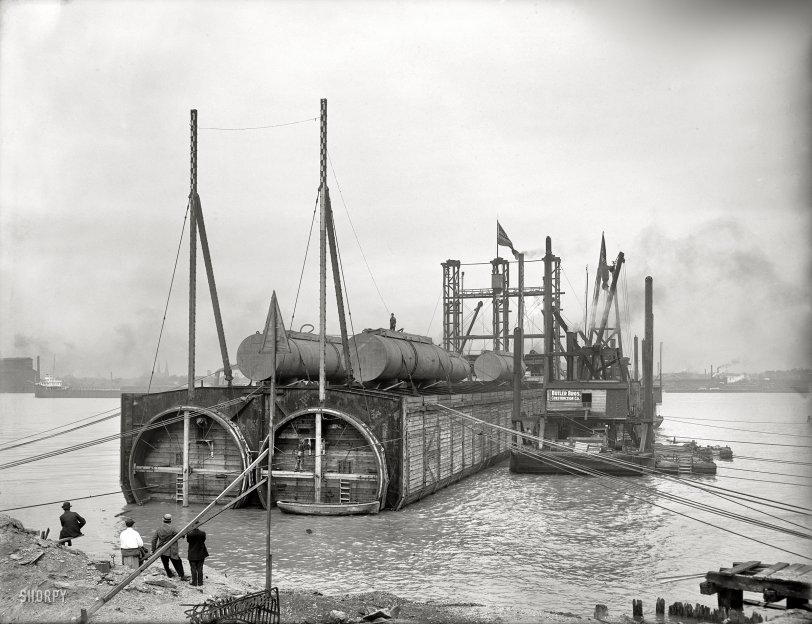


Framed or unframed, desk size to sofa size, printed by us in Arizona and Alabama since 2007. Explore now.
Shorpy is funded by you. Patreon contributors get an ad-free experience.
Learn more.

- Baldwin 62303
- Baldwin VO-1000
- Cold
- No expense spared
- Tough Guys
- Lost in Toyland
- And without gloves
- If I were a blindfolded time traveler
- Smoke Consumer Also Cooks
- Oh that stove!
- Possibly still there?
- What?!?
- $100 Reward
- Freeze Frame
- Texas Flyer wanted
- Just a Year Too Soon
- WWII -- Replacing men with women at the railroad crossing.
- Yes, Icing
- You kids drive me nuts!
- NOT An Easy Job
- I wonder
- Just add window boxes
- Icing Platform?
- Indiana Harbor Belt abides
- Freezing haze
- Corrections (for those who care)
- C&NW at Nelson
- Fallen Flags
- A dangerous job made worse
- Water Stop
Print Emporium
Sinking the Tunnel: 1910

The Detroit River circa 1910. "Sinking cast section of Michigan Central Railroad Company tunnel." Detroit Publishing Company glass negative. View full size.
A Most Daring Plan
History of Detroit
A Chronicle of its Progress, its Industries, its Institutions,
and the People of the Fair City of the Straits,
1912W. S. Kinnear, then chief engineer of the Michigan Central, a man of extraordinary engineering ability, was appointed one of a board of construction and gave ear to what was then considered a most daring plan of construction. There was no precedent to follow. The idea was entirely new. It was the open trench idea, now brought to a successful conclusion.The plans as submitted by Butler Brothers, Hoff and Company, contemplated the digging of an open trench in the river bottom, deep enough to allow the top of the tunnel to be slightly below the river bed. The plan as outlined, and finally adopted, was to dig a V shaped trench in the bottom of the river, twenty-five feet at its base and wide enough at the top to embrace a two-bore tunnel. The bottom of the trench was to be lined with rubble and cement. Twin tubes were constructed at the St. Clair shipyards of the Great Lakes Engineering Company. They were 260 feet long and 22 feet in the clear, in the inside. These tubes were built upon the ways as if they were ships, and were connected with iron bolts. At a distance of every eleven feet, there were placed steel diaphrams sloping from the top to the bottom, so as to conform to the shape of the trench in the bottom of the river. Outside of the diaphrams was placed a sheathing of plank, which served as a buoy which would float the tubes when launched. The tubes were bulkheaded up and when launched were towed from St. Clair to Detroit, where they were placed in position in the trench by means of tugs and divers. So close was the calculation that there was not an error of more than an eighth of an inch in the entire tunnel.
Preparatory to the sinking of the tubes, what were called gridiron saddles, of steel, projecting about four feet above the bottom of the trench, were so placed that the end of each tube would occupy one-half of each saddle. The projecting diaphrams planked as stated, formed pockets without bottoms into which was forced under hydraulic pressure, concrete which not only filled the pockets, but was forced below and beneath the tubes when placed, and carried up and arched in each pocket overhead, in such a manner as to enclose the placed tubes in a monolithic mass. As fast as the tubes were placed in position, the flange of one fitting into the socket of the other, a rubber gasket being in position, the space between the two joining ends was filled with cement grout so that the joints were absolutely air tight. When the process of filling one pocket began it was kept up until that pocket with its arched top was complete. This was done for the reason that had not this course been pursued, there would have been a cleavage line which would have admitted a seepage which would have eventually been disastrous. These tubes were laid for 1,540 feet, the total length of the tunnel being 7,860 feet.
Don't build 'em like that anymore
Still there
The Detroit/Windsor railroad tunnel under the Detroit River is still there and still being used by Canadian Pacific. Sorry to note that Google Maps doesn't have a very good view of it.
Still going strong
The tunnel is still in daily use today. Here is a 1991 video showing both entrances to the tunnel (Detroit and Windsor) and trains using it.
First vehicular
The first immersed tube tunnel was the Shirley Gut Syphon, a sewer line in Boston built in 1893, but this was the first train tunnel built with this method.

























On Shorpy:
Today’s Top 5